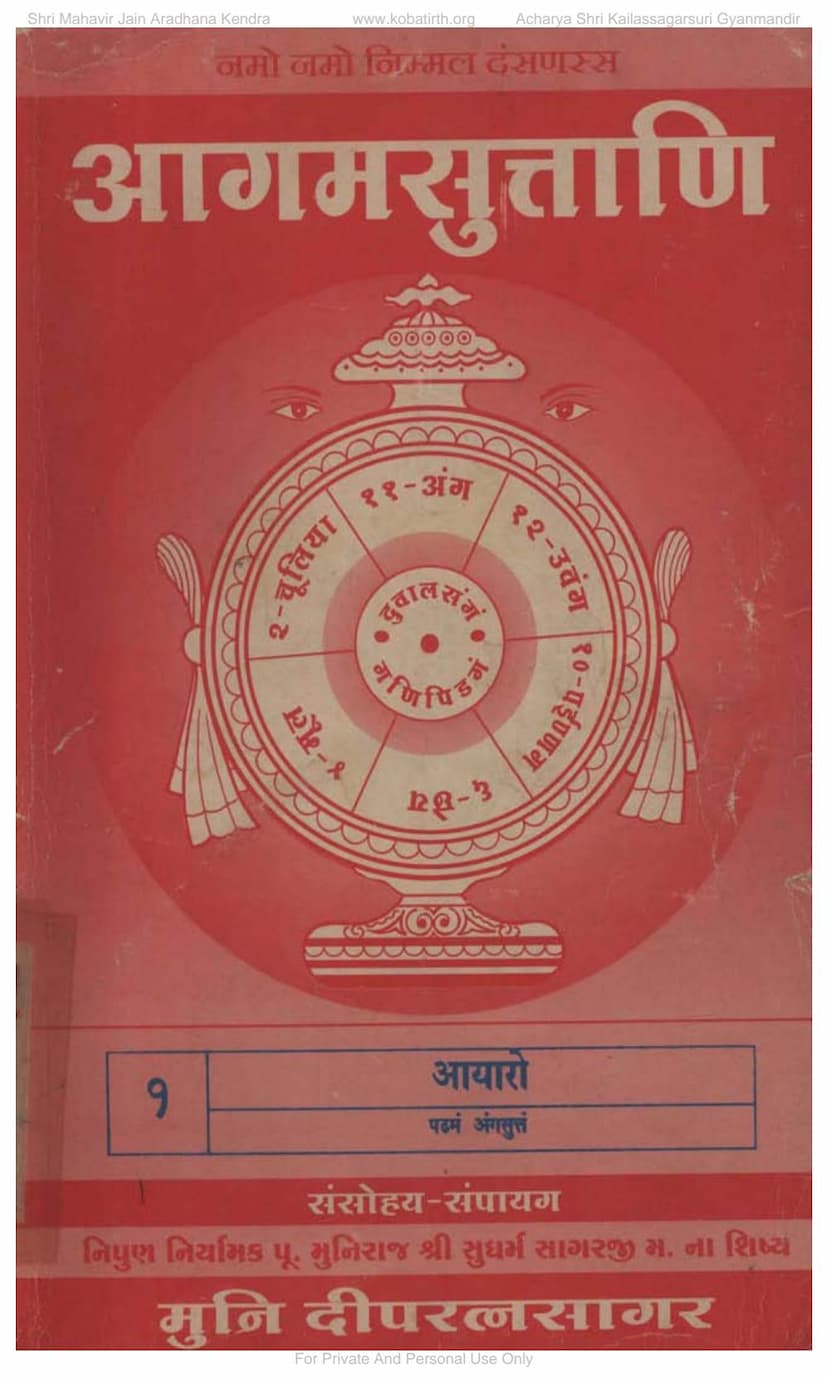Agam 01 Ayaro Angsutt 01 Moolam
Added to library: September 1, 2025

Summary
This Jain text, "Agam 01 Ayaro Angsutt 01 Moolam" by Dipratnasagar and Deepratnasagar, published by Agam Shrut Prakashan, is the first Anga (limb) of the Jain Agamas, titled "Aayaro" (likely referring to Acharanga Sutra). The provided pages primarily consist of:
-
Title and Author Information: The book clearly identifies its title, authors, publisher, and a catalog link. It also emphasizes that the content is for "Private And Personal Use Only" and is presented by the "Shri Mahavir Jain Aradhana Kendra" and "Acharya Shri Kailassagarsuri Gyanmandir."
-
Structure of Jain Agamas: Page 1 visually depicts a hierarchical structure of Jain scriptures, showing the "Duval Sam" (Twelve Angas), "Uvanga" (Upangas), "Paiṇṇag" (Painna), "Samsōhaya-Sampāyaga" (likely referring to Sūtras for purification and attainment), and other classifications like "Gani," "Suchi," "Chulia," and "Mul."
-
Acknowledgments and Sponsorship: A significant portion of the initial pages (Pages 3, 4, and 5) is dedicated to listing numerous individuals, families, and Jain Sanghas (communities) who provided financial contributions (arthik anudan) for the publication of the 45 Agamas. These acknowledgments are often linked to specific Sadhvis (female ascetics) and their inspirational guidance, as well as commemorating spiritual achievements like fasting (upavas) or the memory of deceased individuals. The generosity of these patrons is highlighted, indicating a community-driven effort to preserve and disseminate the Jain Agamas.
-
List of Published Works: Page 6 and parts of subsequent pages provide a comprehensive list of other published works by "Abhinav Hem Laghuprkriya," "Agam Shrut Prakashan," and related institutions. This list covers a wide range of Jain texts, commentaries, calendars, and guides, showcasing a prolific publishing output.
-
Detailed Content of Acharanga Sutra (Aayaro): The bulk of the provided text (Pages 12 through 109) is a detailed rendering of the Acharanga Sutra. This includes:
- Chapter and Section Breakdown: The text is systematically organized into chapters (Adhyayan) and sections (Uddeso). For instance, the first chapter (Padame Adhyayane) is shown to have five sections, detailing various aspects of conduct and ethical principles.
- Sutras and Verses: Each section contains numbered sutras (verses or aphorisms) in Prakrit (or a related Ardhamagadhi language). These sutras are presented with their corresponding English numbering and, in some cases, cross-references within the text (indicated by "R" or English numerals).
- Themes within the Acharanga Sutra: Based on the sutra titles and the initial verses, the Acharanga Sutra appears to focus on fundamental Jain principles, including:
- The nature of the soul (Aya): Discussions about the soul, its origin, and its journey.
- Karma and its effects: The concept of karma, how actions lead to consequences, and the cycle of birth and death.
- Right Conduct (Achar): The text elaborates on ethical behavior, distinguishing between permissible and impermissible actions. It emphasizes the importance of understanding the karmic implications of every action.
- Sensory experience and attachment: The text delves into how sensory perceptions and attachments contribute to suffering and the cycle of rebirth.
- The path of liberation: It outlines the principles and practices that lead to spiritual liberation (moksha) from worldly bondage.
- The conduct of ascetics: The sutras provide detailed guidelines for monks and nuns regarding their daily activities, interactions, and adherence to vows. This includes strict rules concerning movement, speech, food, and interactions with the environment and living beings.
- The classification of living beings: The text likely touches upon the classification of various life forms (e.g., mobile and immobile, gross and subtle) and the ethical considerations in interacting with them.
- The importance of introspection and mindfulness: The emphasis on understanding one's actions and intentions suggests a strong focus on self-awareness and conscious living.
-
The "Aayaro" or Acharanga Sutra: This text is considered the first and foundational scripture of the Svetambara tradition of Jainism. It lays down the fundamental principles of ascetic conduct and the ethical framework for Jain monks and nuns, covering aspects like:
- Himsa (Violence): Detailed discussions on the nature of violence, its causes, and how to avoid it in thought, word, and deed, extending to even the smallest organisms.
- Speech (Vach): Strict guidelines on the quality and intent of speech, emphasizing truthfulness, non-offensiveness, and refraining from gossip or harmful talk.
- Action (Kayaman): Rules governing physical actions, ensuring minimal harm to oneself and others, and mindful movement.
- Possessions (Parigraha): The principles of non-attachment and limiting possessions to the bare essentials required for spiritual practice.
- Mind (Man): The importance of controlling thoughts, desires, and emotions to maintain equanimity and focus on spiritual goals.
In essence, the provided pages offer a glimpse into the structure of Jain Agamic literature and provide a substantial portion of the Acharanga Sutra, which serves as a foundational text for Jain monastic life, emphasizing rigorous ethical conduct, self-discipline, and the pursuit of liberation through non-violence and detachment.